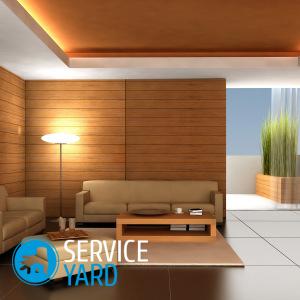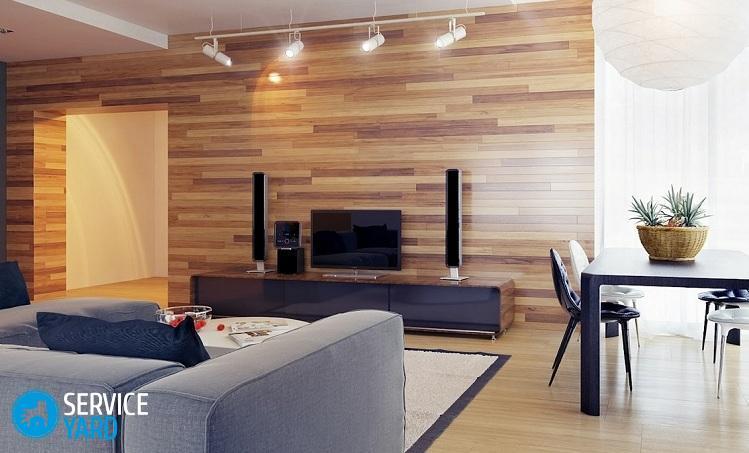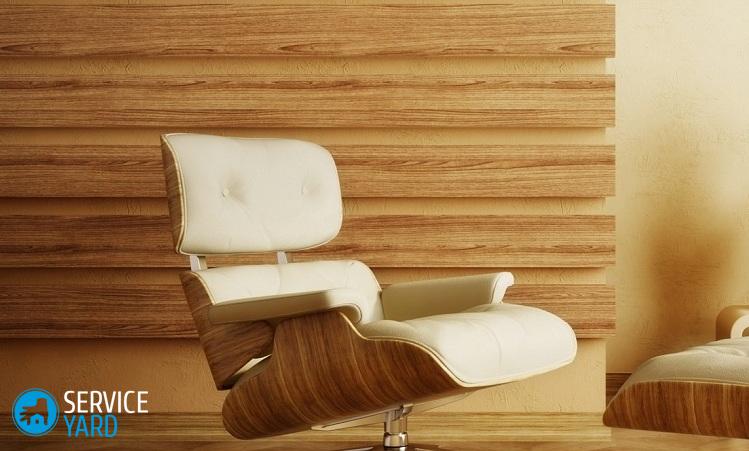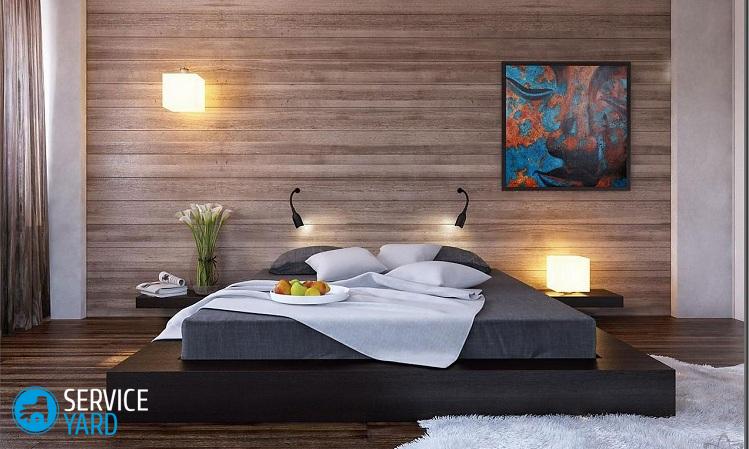Laminate wall decoration

Laminate is one of the most popular materials for decorating living spaces. This material has a layered structure, and on top is covered with a wear-resistant polymer film, which carries both protective and decorative functions. Previously, laminate boards were used exclusively as a floor covering, but due to their first-class characteristics and beautiful aesthetic appearance, such material was also widely used for decorative wall cladding. In this case, it serves as an excellent substitute for wood and MDF panels. The walls are laminated with the help of specialists or independently. In the second case, the cheapest model range of this material will be enough for you, as well as a simple desire.
to contents ↑Panel device
As mentioned earlier, a decorative laminate board has a layered structure and consists of such layers:
- Lower. This is a stabilizing layer that protects the board from deformation. It also increases the rigidity of the material itself.
Important! In some model ranges of the laminate, a special substrate is also glued to the lower layer for additional sound insulation.
- The basis. It is a carrier layer, which consists of wood fibers and is characterized by high density. It carries all the basic functions of a laminate board. The main layer is treated with moisture-resistant impregnation, and also a special lock is fixed on it, designed to fix the material between each other.
- Decorative. Represents paper with the drawing applied over imitating a tree, a stone or other natural materials.
- Upper. This is a melamine or acrylic resin, which performs a protective function against premature abrasion and shock loads. Depending on how thick the top coat was applied, the class of the material itself is determined.
to contents ↑Important! Today, the top layer plays not only a protective, but also a decorative role. This is due to the fact that a texture is applied to it in order to further enhance the similarity with the material that is simulated.
The main characteristics and varieties of the laminate
Also, before you finish the walls with a laminate yourself, it is very important to familiarize yourself with the classification of this material, since its operational qualities completely depend on it.
Laminate boards are classified according to EN 13329 - these are European standards that require testing of the material in eighteen quality parameters.
Important! The term “class” means the allowable load on the plate, as well as its density. This parameter has indicators in the range from 21 to 34. As for the wear resistance of the upper layer, it is determined by the AC indicator.
In the main classification, laminate boards are divided into four classes:
- Used for home use - 21-33;
- For home use with increased load or commercial, but with a low load - 32 class;
- At high loads for commercial use - 33 class;
- As for sports and industrial use, 34 class should be applied, since it is the most durable.
Important! The last three classes are mainly used for covering floors, but for a wall sheathing, a laminate of class 21 is quite suitable.
Laminate boards are also separated by the method of their fastening.
- Glue. A feature of this method of fastening is that the connection and fastening of the plates on the wall is done with glue. Laying in this case is quite simple, but you will have to tinker with dismantling.
- Groovy. It is characterized by the presence of special locks in its design. During installation, they form a tongue-and-groove connection between them in the form of a tenon groove. On the walls of such panels are fastened with small nails or clamps.
- Clicky. A feature of this method is its fastening, which is somewhat reminiscent of sheet pile, but it is much simpler. Installation on the wall occurs by attaching panels at an angle of 20 degrees. In this case, the grooves are joined, as a result of which the overall structure is latched onto them.
The main advantages and disadvantages of laminate boards
In addition to the fact that this material during interior decoration looks quite expensive and respectable, it also has a number of advantages:
- Durability. In the case of proper care and proper operation, laminate boards can last for more than one year.
- A large assortment of different textures and rich colors. This gives ample opportunity in interior decoration.
- Ease of installation. Due to this, installation and fastening to the wall surface can be done even by a novice who has not previously encountered this material.
- Practicality. Laminate does not accumulate dust, does not absorb moisture and various odors.
Unfortunately, laminate flooring has a number of drawbacks that, for one reason or another, limit its use:
- Boards are unstable to an excess of moisture. When very wet, they begin to swell and become covered with cracks. Therefore, wall cladding with this material is not recommended in rooms with high humidity, such as a bathroom and kitchen.
- Instability to sharp temperature changes. In the heat, such a lining burns out and swells, but at low temperatures it cracks. Therefore, wall cladding with a laminate should not be done in open rooms, such as a balcony and a loggia.
- The presence of melamine resin in the topcoat. If you rely on the opinion of some experts, this substance negatively affects human health, so you should not use such panels in bedrooms or children's rooms.
How to choose the right material?
Before lining the walls with laminate, it is necessary with all responsibility to approach the choice of this material. The most important thing is not to immediately rush at a low price. Of course, the load in this case will be much lower than when used for flooring. However, for a longer service life, when choosing a laminate for interior wall cladding, you need to consider such factors:
- If you want to finish the walls of the kitchen or the room where active pets live, it is better to purchase material in a class of at least 23.
- Always focus on the general style of interior design and your design.
- Pay attention to the installation method of the material you have chosen, whether it is acceptable to you.
to contents ↑Important! Modern manufacturers have already begun to produce special ranges of laminate flooring, which are used exclusively for decorative wall cladding.
Lining the walls with laminate - installation technology
As in other construction and repair works, the process of installing laminate panels on walls is carried out in several stages. In this case, this is the preparatory work and the installation itself. Next, we will describe in more detail about each of these stages.
Preparing walls for the installation of laminate panels
Before you begin to perform any work on wall cladding with laminate, it is necessary to prepare the tools. You will need:
- Jigsaw, files and other consumables to it;
- Half kilogram hammer;
- Square and ruler;
- Roulette;
- Pencil;
- Plastic bar;
- Wedges for restriction;
- Staples for tamping panels;
- Drill;
- Hammer drill;
- Angle cutter;
- Hacksaw.
If the installation will be done on the crate, you will also need metal profiles or wooden slats with a section of 40x20 millimeters.
Important! If you do not have experience with a metal profile, it is better to use then wooden slats for the construction of the lathing.
Helpful hints:
- Laminate panels are very sensitive and cannot tolerate high humidity, respectively - the gap from the corners and the floor to the ends of the plates should be about 2 centimeters. Therefore, it is advisable to lay a wooden lath on the floor. Wedges in this case are laid only on the sides of the panel.
- If the adhesive mounting method is used, the rail must be wrapped with plastic wrap. This is necessary in order to prevent bonding of the support and the slab.
- Also, in the preparation process, you need to calculate the number of panels you need. The calculation is carried out by the following method: multiply the height by the length of the wall and add 10% to the resulting number.
Mounting laminate panels on the wall
Depending on the method of fastening you have chosen, the lining of the walls with a laminate occurs according to a certain algorithm of work.
Glue method:
- Plaster the wall with starting plaster or install a drywall frame.
Important! The curvature of the wall plane may fluctuate within 2 millimeters.
- Apply glue to the back of the panel and attach it to the wall.
Important! It is best to start installation from the corner of the room. In order to ensure damper clearance, you can use wooden wedges or screw in a few screws.
- Grease joints with silicone. This is necessary to seal the surface.
- Similarly, paste over the entire room.
Crate mounting
This method is the most practical - in case of deformation of the panel, it can easily be dismantled and replaced with a new one.
Important! The main advantage of the installation method on the crate is that if over time you change the interior decoration of the walls, a new one can be installed on the same crate.
Also, with this method of fastening, one should take into account the fact that the crate must be mounted based on the direction of laying the laminate, which should be perpendicular to the finish.
Important! If you plan the diagonal installation of panels, the crate must be done horizontally.
The following work algorithm consists of the following stages:
- According to the level, place the strips at a distance of 30-40 centimeters from each other and attach to the wall with dowels.
Important! To align the plane under the bar, you can put a lining.
- Install the beacons and start installing the laminate. Fasten the first bar with self-tapping screws or small studs. Later, this mount will be closed.
- Secure the strap with brackets on the other side. Attaching them is not necessary. You just need to fix the staples in a checkerboard pattern.
Important! You can carry out the fixation without the clamps, and fasten the panels into the groove with small screws or studs. Unfortunately, in this case, the dismantling will take place with a complete destruction of the groove.
- Place the next bar in the groove at an angle of 45 degrees and press it against the wall plane. After the grooves click into place, you can proceed to fixation with the clamps. Thus, the entire room is sheathed.
Stock footage
Partial upholstery of the room with laminate today is increasingly gaining popularity among designers. For the fact that such a decorative finish has an attractive and sophisticated appearance, it costs quite inexpensively. We hope that the recommendations of our experts will encourage you to conduct an independent wall sheathing with a laminate and help to make a stylish and high-quality repair.
- How to choose a vacuum cleaner taking into account the characteristics of the house and coatings?
- What to look for when choosing a water delivery
- How to quickly create comfort at home - tips for housewives
- How to choose the perfect TV - useful tips
- What to look for when choosing blinds
- What should be running shoes?
- What useful things can you buy in a hardware store
- Iphone 11 pro max review
- Than iPhone is better than Android smartphones






